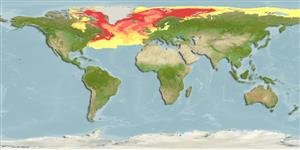Common names from other countries
Environment: milieu / climate zone / depth range / distribution range
Ecologie
Bathydemersaal; diepteverspreiding 0 - 6000 m (Ref. 356). Boreal; 90°N - 0°S, 97°W - 180°E
Atlantic Ocean and the Arctic: North Atlantic Ocean, Arctic Ocean, Baffin Island, Magdalen Island, Russia, Canada (Ref. 1394). Pagophilus groenlandicus groenlandicus: Newfoundland, Jan Mayen (Norway), Baffin Bay, Greenland Sea, Nova Scotia, Greenland, Iceland; and vagrants in Virginia, Scotland, Germany, France; Pagophilus groenlandicus oceanicus: Barents Sea, Russia, White Sea (Ref. 1522).
Length at first maturity / Size / Gewicht / Leeftijd
Maturity: Lm ? range ? - ? cm Max length : 190 cm TL mannelijk/geslacht niet bekend; (Ref. 1394); 180 cm TL (female); Maximaal gepubliceerd gewicht: 135.0 kg (Ref. 1394); Maximaal gepubliceerd gewicht: 135.0 kg
Live chiefly in pack ice, but can be found away from it in summer. Feeds on a variety of crustaceans and open-water fishes during migration, and switch to several varieties of bottom dwelling fishes in summer on the northern grounds (Ref. 1394).
Jefferson, T.A., S. Leatherwood and M.A. Webber. 1993. (Ref. 1394)
Status op de Rode Lijst van het IUCN (Ref. 130435: Version 2024-1)
Status bij CITES (Ref. 108899)
Not Evaluated
Not Evaluated
Gebruik door de mens
Visserij: commercieel
FAO - Visserij: landings, soortsprofiel | FIRMS (Stock assessments) | FishSource | Sea Around Us
Tools
Internet-bronnen
Estimates based on models
Preferred temperature
(Ref.
115969): -0.9 - 4.1, mean 0.6 (based on 2101 cells).
Kwetsbaarheid
High to very high vulnerability (71 of 100).
Prijsklasse
Unknown.
